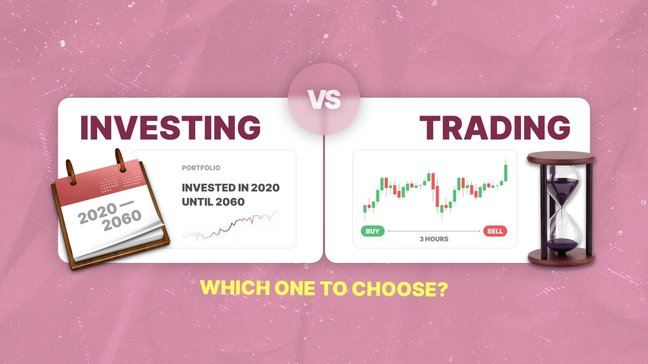Investing Vs. Trading: Which One to Choose?
Stock traders apply different ways to make money. On the whole, all their approaches are boiled down to two major options: trading and investing. In the modern financial world, the difference between these two approaches has almost vanished.

Originally, investing and trading are different approaches to reaching the same goal. The time horizon and mindset are the two factors that make both approaches vary. When we say “time horizons”, we mean timeframes you are willing to hold.
A mindset represents your trading personality. Are you aiming to gain fast profit or prefer holding longer for bigger wins in the long-term perspective?
In this article, we will highlight the key differences and criteria that make investing different from stock trading.
The Difference between Investing and Trading
Every trading style comes with specific requirements. For example, trading is usually associated with the way of making money by acting. Oppositely, investing is the process of gaining wealth by waiting. To make this concept a bit easier for understanding, we will break down all major differences that show one concept against another.
Stock Investing
When you invest in stocks, your mindset reflects a long-term perspective. In simpler words, you purchase an asset to wait for as long as needed until it will provide enough return. Investors usually do the following:
up to 200%

from 0 pips

Trading platform

- They treat their assets like owners without the will to sell as soon as the slightest price change takes place.
- Investors take into account business performance as the fundamental data to evaluate the asset. It also means considering the business as a business with its products, competitive advantages, niche rivals, and so on.
- Daily fluctuation does not matter. Investors keep it cool even when the market experiences day-to-day turbulence, as they do not depend on short timeframes. Investors rely on long-term company strategies and primary goals. It calls for discipline and patience to stick to the plan, especially during the market crash.
- Stock price decrease means the possibility to buy more assets at a huge discount.
- The investment process is based on discipline and well-planned actions. Investors do not buy or sell assets just because they worked out the previous day.
An investor is a person with a long-term mindset and well-planned business processes. Not all beginners are ready for this. Besides, with so many financial markets and assets to trade, one can find faster and less demanding ways to win big, though with much higher risks involved.
Stock Trading
With stock trading, the main focus is made on short-term opportunities to make a profit. Stock traders do not care much about the company’s performance or fundamental data. They rely mainly on technical analysis, price movement, trends, and other crucial factors that help them make short-term predictions and define the best market entry and exit positions.
Stock trading is an active approach where market participants buy and sell many assets within a short period. The key features of this approach are as follows:
- Traders do not have a keen interest in the company and the way it performs. They care mainly about the stock price. Stock traders pay attention to the amount of money they can make with an underlying asset.
- The strategy considers market sentiments and other traders’ opinions about the situation on the stock market.
- Traders use technical indicators and charts to track the asset price movement and predict when it is the best time to enter the market with either a long or short position.
- Stock traders’ behavior is more driven by the stock price rather than fundamental business parameters. This is why they generally look for instruments that are about to rise in price.
- Holding periods are very short, usually, not longer than 1 day.
- Stock traders also have a plan. However, it is more complicated if compared with the investment plan with many different factors that help traders make buying or selling decisions accordingly.
Stock traders are very active and keep a short-term orientation. They analyze the market, trends, and prices instead of the business itself. The quicker they win a buck, the better.
Stock Trading or Investing: Which Is Better?
The two approaches have many similarities. However, investing is more about passive income while trading suits active market participants more.
When you invest in stocks, you generally prefer buy-and-hold techniques that are based on the fundamental performance of the underlying company. The generated data will make it possible to drive higher returns. The only problem here is that returns hardly exceed 10%.
Stock trading offers more flexible options, as one can use a variety of indicators to apply different strategies depending on the time frame or goals. The main mission here is to grab the best trading opportunity and avoid assets with falling prices.
The Bottom Line
Traders and investors have different business goals and tools to achieve them. Before selecting the methodology that meets your needs, it is better to test both tactics in demo mode. Additionally, it is better to have a clear plan with transparent trading goals and profits you want to gain. The plan usually contains timeframes and means to initiate daily trades.
If you do not feel like engaging with the stock market each day and look for a passive income instead, investing is the one to choose. Oppositely, if you want to play actively in the market and take every slightest opportunity to make a profit, trading will be a better option.
This material does not contain and should not be construed as containing investment advice, investment recommendations, an offer of or solicitation for any transactions in financial instruments. Before making any investment decisions, you should seek advice from independent financial advisors to ensure you understand the risks.
